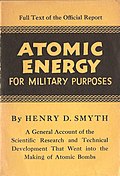Wikipedia:Today's featured article/requests/Smyth Report
Smyth Report
[edit]- This is the archived discussion of the TFAR nomination for the article below. Subsequent comments should be made on the appropriate discussion page (such as Wikipedia talk:Today's featured article/requests). Please do not modify this page.
The result was: scheduled for Wikipedia:Today's featured article/August 12, 2015 by — Chris Woodrich (talk) 04:45, 24 July 2015 (UTC)
The Smyth Report is the common name of an administrative history written by physicist Henry DeWolf Smyth about the Manhattan Project, the Allied effort to develop atomic bombs during World War II. The full title of the report is A General Account of the Development of Methods of Using Atomic Energy for Military Purposes. It was released to the public on August 12, 1945, just days after the atomic bombings of Hiroshima and Nagasaki on August 6 and 9 respectively. Smyth was commissioned to write the report by Major General Leslie R. Groves, Jr., the director of the Manhattan Project. The Smyth Report was the first official account of the development of the atomic bombs and the basic physical processes behind them. It also served as an indication as to what information was declassified; anything in the Smyth Report could be discussed openly. For this reason, the Smyth Report focused heavily on information, such as basic nuclear physics, which was either already widely known in the scientific community or easily deducible by a competent scientist, and omitted details about chemistry, metallurgy, and ordnance. This would ultimately give a false impression that the Manhattan Project was all about physics. The Smyth Report sold almost 127,000 copies in its first eight printings, and was on the New York Times best-seller list from mid-October 1945 until late January 1946. It has been translated into over 40 languages. (Full article...)
- Most recent similar article(s): Fantastic Novels (30 June)
- Main editors: Hawkeye7
- Promoted: 29 December 2014
- Reasons for nomination: 70th Anniversary of first publication
- Support as nominator. Hawkeye7 (talk) 00:44, 29 June 2015 (UTC)
- NB: The image is of my own copy. Hawkeye7 (talk) 00:48, 29 June 2015 (UTC)
- Note to nominator: Please add this nomination to the summary table above. Brianboulton (talk) 14:49, 30 June 2015 (UTC)
- Support Anniversary is a good reason. Headbomb {talk / contribs / physics / books} 21:12, 30 June 2015 (UTC)
- Support Per anniversary Cas Liber (talk · contribs) 00:42, 19 July 2015 (UTC)

